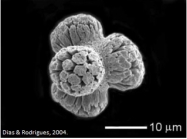
| About | | Search taxa | | Taxon tree | | Search literature | | Checklist | | Stats | | Log in |
WoRMS taxon detailsDidemnum tetrahedrum Dias & Rodrigues, 2004
266058 (urn:lsid:marinespecies.org:taxname:266058)
accepted
Species
marine,
Dias, G. M.; De Almeida Rodrigues, S. (2004). Didemnum tetrahedrum sp. nov., a new Didemnum (Tunicata: Ascidiacea) species from south-eastern Brazil. <em>Journal of the Marine Biological Association of the UK.</em> 84(6): 1227-1228., available online at https://doi.org/10.1017/s0025315404010707h [details] Available for editors
Holotype MZUSP 16208, geounit Brazil Southeast
Holotype MZUSP 16208, geounit Brazil Southeast [details] type locality contained in São Paulo [details]
Description Colonies very thin, less than 1mm thick, sheet-like, less than 10 cm across, usually formed by small irregular plates...
Description Colonies very thin, less than 1mm thick, sheet-like, less than 10 cm across, usually formed by small irregular plates anastomosing with one another. Colour milky white, sometimes slightly orange (Figure 2). Spicules of small size, around 30 mm across (size-range: 13 to 33 mm), densely packed throughout the test, tetrahedral in shape, formed by four rounded calcareous masses. Zooids yellow or orange, less than 1mm long, not seen through the tunic. Branchial siphon short, with six lobes atrial aperture a wide cleft exposing much of the branchial sac. The anterior half-row has ¢ve stigmata, reducing to four in the second and third rows, and to three stigmatain the posterior row, although the exact number in this last one is obscured by contraction. Muscular process stout, about half as long as the thorax. Elliptical lateral organs, opposite the third row of stigmata, distinguishable by aggregation of spicules around them (Figure 3A). Oesophageal neck, always, surrounded by spicules. Testis undivided, with seven to nine counterclockwise spiral turns (Figure 3B). Ovary with a single large egg (Figure 3C), never observed occurring simultaneously with testis. Larval trunk about 0.5 mm long, three adhesive papillae, four pairs of lateral ampullae and the tail is wound halfway around the trunk (Figure 3D). [details] Etymology The species name refers to the peculiar aspect of the spicules.
Etymology The species name refers to the peculiar aspect of the spicules. [details]
Shenkar, N.; Gittenberger, A.; Lambert, G.; Rius, M.; Moreira da Rocha, R.; Swalla, B.J.; Turon, X. (2024). Ascidiacea World Database. Didemnum tetrahedrum Dias & Rodrigues, 2004. Accessed through: World Register of Marine Species at: https://www.marinespecies.org/aphia.php?p=taxdetails&id=266058 on 2024-05-21
Date action by
original description
Dias, G. M.; De Almeida Rodrigues, S. (2004). Didemnum tetrahedrum sp. nov., a new Didemnum (Tunicata: Ascidiacea) species from south-eastern Brazil. <em>Journal of the Marine Biological Association of the UK.</em> 84(6): 1227-1228., available online at https://doi.org/10.1017/s0025315404010707h [details] Available for editors
basis of record van der Land, J. (ed). (2008). UNESCO-IOC Register of Marine Organisms (URMO). , available online at http://www.marinespecies.org/urmo/ [details]  Present Present  Present in aphia/obis/gbif/idigbio Present in aphia/obis/gbif/idigbio  Inaccurate Inaccurate  Introduced: alien Introduced: alien  Containing type locality Containing type locality
Holotype MZUSP 16208, geounit Brazil Southeast [details]
Paratype MZUSP 16209, geounit Brazil Southeast [details]
Paratype MZUSP 16210, geounit Brazil Southeast [details]
From editor or global species database
Description Colonies very thin, less than 1mm thick, sheet-like, less than 10 cm across, usually formed by small irregular plates anastomosing with one another. Colour milky white, sometimes slightly orange (Figure 2). Spicules of small size, around 30 mm across (size-range: 13 to 33 mm), densely packed throughout the test, tetrahedral in shape, formed by four rounded calcareous masses. Zooids yellow or orange, less than 1mm long, not seen through the tunic. Branchial siphon short, with six lobes atrial aperture a wide cleft exposing much of the branchial sac. The anterior half-row has ¢ve stigmata, reducing to four in the second and third rows, and to three stigmatain the posterior row, although the exact number in this last one is obscured by contraction. Muscular process stout, about half as long as the thorax. Elliptical lateral organs, opposite the third row of stigmata, distinguishable by aggregation of spicules around them (Figure 3A). Oesophageal neck, always, surrounded by spicules. Testis undivided, with seven to nine counterclockwise spiral turns (Figure 3B). Ovary with a single large egg (Figure 3C), never observed occurring simultaneously with testis. Larval trunk about 0.5 mm long, three adhesive papillae, four pairs of lateral ampullae and the tail is wound halfway around the trunk (Figure 3D). [details]Diagnosis Colonies thin, encrusting, whitish with densely packed spicules of rounded tetrahedral shape. Zooids less than 1mm long, with testis undivided and sperm-duct with seven to nine coils; ovary with one large egg, never simultaneously with the testis. Larvae with three papillae and four pairs of lateral ampullae. [details] Etymology The species name refers to the peculiar aspect of the spicules. [details] Genetic nomenclature abbreviation Ditetr [details] |

